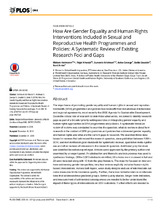| dc.contributor.author | Hartmann, Miriam | |
| dc.contributor.author | Khosla, Rajat | |
| dc.contributor.author | Krishnan, Suneeta | |
| dc.contributor.author | George, Asha S. | |
| dc.contributor.author | Gruskin, Sofia | |
| dc.contributor.author | Amin, Avni | |
| dc.date.accessioned | 2017-06-05T09:23:12Z | |
| dc.date.available | 2017-06-05T09:23:12Z | |
| dc.date.issued | 2016 | |
| dc.identifier.citation | Hartmann, M. et al. (2016). How are gender equality and human rights interventions included in sexual and reproductive health programmes and policies: a systematic review of existing research foci and gaps. PLoS ONE, 11(12): e0167542. | en_US |
| dc.identifier.issn | 1932-6203 | |
| dc.identifier.uri | http://hdl.handle.net/10566/2923 | |
| dc.identifier.uri | http://dx.doi.org/10.1371/journal.pone.0167542 | |
| dc.description.abstract | The importance of promoting gender equality and human rights in sexual and reproductive health (SRH) programmes and policies has been affirmed in numerous international and regional agreements, most recently the 2030 Agenda for Sustainable Development. Given the critical role of research to determine what works, we aimed to identify research gaps as part of a broader priority setting exercise on integrating gender equality and human rights approaches in SRH programmes and policies. A systematic literature review of reviews was conducted to examine the question: what do we know about how research in the context of SRH programmes and policies has addressed gender equality and human rights and what are the current gaps in research. We searched three databases for reviews that addressed the research question, were published between 1994-2014, and met methodological standards for systematic reviews, qualitative meta-syntheses and other reviews of relevance to the research question. Additional grey literature was identified based on expert input. Articles were appraised by the primary author and examined by an expert panel. An abstraction and thematic analysis process was used to synthesize findings. Of the 3,073 abstracts identified, 56 articles were reviewed in full and 23 were included along with 10 from the grey literature. The majority focused on interventions addressing gender inequalities; very few reviews explicitly included human rights based interventions. Across both topics, weak study designs and use of intermediate outcome measures limited evidence quality. Further, there was limited evidence on interventions that addressed marginalized groups. Better quality studies, longer-term indicators, and measurement of unintended consequences are needed to better understand the impact of these types of interventions on SRH outcomes. Further efforts are needed to cover research on gender equality and human rights issues as they pertain to a broader set of SRH topics and populations. | en_US |
| dc.language.iso | en | en_US |
| dc.publisher | Public Library of Science | en_US |
| dc.rights | Copyright 2016 Hartmann et al. This is an open access article distributed under the terms of the Creative Commons Attribution License, which permits unrestricted use, distribution, and reproduction in any medium, provided the original author and source are credited. | |
| dc.subject | Database | en_US |
| dc.subject | Exercise | en_US |
| dc.subject | Female | en_US |
| dc.subject | Gender | en_US |
| dc.subject | Human rights | en_US |
| dc.subject | Reproductive health | en_US |
| dc.subject | Synthesis | en_US |
| dc.subject | Systematic review | en_US |
| dc.subject | Thematic analysis | en_US |
| dc.title | How are gender equality and human rights interventions included in sexual and reproductive health programmes and policies: A systematic review of existing research foci and gaps | en_US |
| dc.type | Article | en_US |
| dc.privacy.showsubmitter | FALSE | |
| dc.status.ispeerreviewed | TRUE | |
| dc.description.accreditation | Scopus | en_US |

